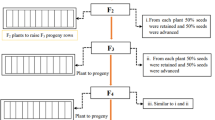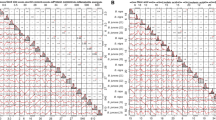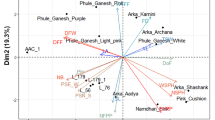Abstract
Variation and heritability of seed mass in the Mesoamerican crop chia, Salvia hispanica L. was studied to examine the feasibility of selection for the trait. Genotypic variation in seed mass in wild/cultivated and domesticated accessions of chia from different origins was assessed. Broadsense heritability of seed mass was estimated using variances associated with parental and F2 generations derived from two crosses and from the response to one cycle of selection. Significant (P . 0.0001) genotypic variation was observed among accessions. Mean seed mass for domesticated accessions (14.84 mg/100 seeds) was greater than that of the wild accessions (11.29 mg/100 seeds) by 31%. The heritability of seed mass was relatively high in chia (0.75), suggesting that this trait is under strong genetic control. This conclusion was supported by a single selection cycle from the F2 to F3 generation that produced a 16% increase in mean seed mass. The realized heritability estimated based on this one cycle of selection also was 0.75. These observations indicate that gains from selection in chia seed mass are possible when mass selection is conducted in early generations. Basic information is thus provided for future breeding efforts in a species for which little or no knowledge of inheritance currently exists.
Similar content being viewed by others
References
R. Ayerza (1995) ArticleTitleOil content and fatty acid composition of chia (Salvia hispanica L.) from five northwestern locations in Argentina J. Am. Oil Chem. Soc. 72 1079–1081 Occurrence Handle1:CAS:528:DyaK2MXotVWju7o%3D
R.H. Busch K. Kofoid (1982) ArticleTitleRecurrent selection for kernel weight in spring wheat Crop Sci. 22 568–572 Occurrence Handle10.2135/cropsci1982.0011183X002200030032x
F.R. Bidinger D.S. Raju (2000) ArticleTitleResponse to selection for increased individual grain mass in pearl millet Crop Sci. 40 68–71 Occurrence Handle10.2135/cropsci2000.40168x
W. Coates R. Ayerza (1996) ArticleTitleProduction potential of chia in northwestern Argentina Indust. Crops Prod. 5 229–233
A. Estilai A. Hashemi K. Truman (1990) ArticleTitleChromosome number and meiotic behavior of cultivated chia, Salvia hispanica (Lamiaceae) HortScience 25 1646–1647
D.S. Falconer T.F.C. MacKay (1996) Introduction to Quantitative Genetics. EditionNumber4 Longman Essex, UK
M.S. Haque K.K. Ghoshal (1981) ArticleTitleFloral biology and breeding system in the genus Salvia L Proc. Indian Natl. Sci. Acad. 47 IssueID5 716–724
J.R. Harlan (1992) Crops and Man American Society of Agronomy Madison,WI.
H.R. Harvey (1991) Land Politics in the Valley of Mexico: A 2000 Year Perspective University of New Mexico Press Albuquerque
J.A. Hernandez Gomez (1989) Efecto de la fecha siembra, densidad de poblacion y competencia de malezas en el rendimiento de chia (Salvia hispanica L.). (Masters) Chapingo Colegio de Postgraduados Universidad Autonoma Mexico
Hernandez Gomez J.A. 1994. In: Cuevas J. (ed.), Chia (Salvia hispanica) Antecedentes y Perspectivas en Mexico. Universidad Autonoma Chapingo, Mexico.
K.Y. Lin J.R. Daniel R.L. Whistler (1994) ArticleTitleStructure of chia seed polysaccharide exudates Carbohydr. Polym. 23 13–18 Occurrence Handle1:CAS:528:DyaK2cXisVartrs%3D
T. Rojas-Rabiela (1988) Las Siembras de Ayer, la Agricultura Indigena del Siglo XVI Secretaria de Educacion Publica Mexico, DF
Sahagun,Fray Bernardino de, 1950–1982. In: Anderson A.J.O. and Dibble C.E. (eds), Florentine Codex: General History of the Things of New Spain, vol. 14. Monographs of the School of American Research, Salt Lake City, University of Utah Press. (Originally written 1575–1577 or 1578–1580).
N.W. Simmonds (1981) Principles of Crop Improvement Longman Group Ltd. New York
SPSS,2000. Sigma plot: exact graphics for exact science. SPSS Science, 2335 S. Wacker Drive, 11th floor, Chicago, Illinois, USA.
R.G.D Steel J.H. Torrie (1980) Principles and Procedures of Statistics: A Biometrical Approach EditionNumber2 McGraw-Hill New York
R.R. Sokal F.J. Rohlf (1995) Biometry: The Principles and Practice of Statistics in Biological Research. EditionNumber3 W.H. Freeman New York
I.P. Ting M. Ahmed R.W. Scora J.H. Brown J.D. Arquette (1996) Terpene composition of chia and chan leaf tissue. Int Conf. on New Industrial Crops and Products. EditionNumber3 University of Arizona Tucson
L.A. Turnbull M. Rees M.J. Crawley (1999) ArticleTitleSeed mass and the competition/colonization trade-off: a sowing experiment J. Ecol. 87 899–912
C.W. Weber H.S. Gentry E.A. Kohlhepp P.R. McCrohan (1991) ArticleTitleThe nutritional and chemical evaluation of chia seeds. Ecol Food Nutr 26 119–125 Occurrence Handle10.1080/03670244.1991.9991195
H. Yu K. Kosuna . Haga M. (Eds) (1997) The Genus Perilla. Harwood Academic Publishers Amsterdam.
Author information
Authors and Affiliations
Corresponding author
Rights and permissions
About this article
Cite this article
Cahill, J.P., Ehdaie, B. Variation and heritability of seed mass in chia (Salvia hispanica L.). Genet Resour Crop Evol 52, 201–207 (2005). https://doi.org/10.1007/s10722-003-5122-9
Received:
Accepted:
Issue Date:
DOI: https://doi.org/10.1007/s10722-003-5122-9




